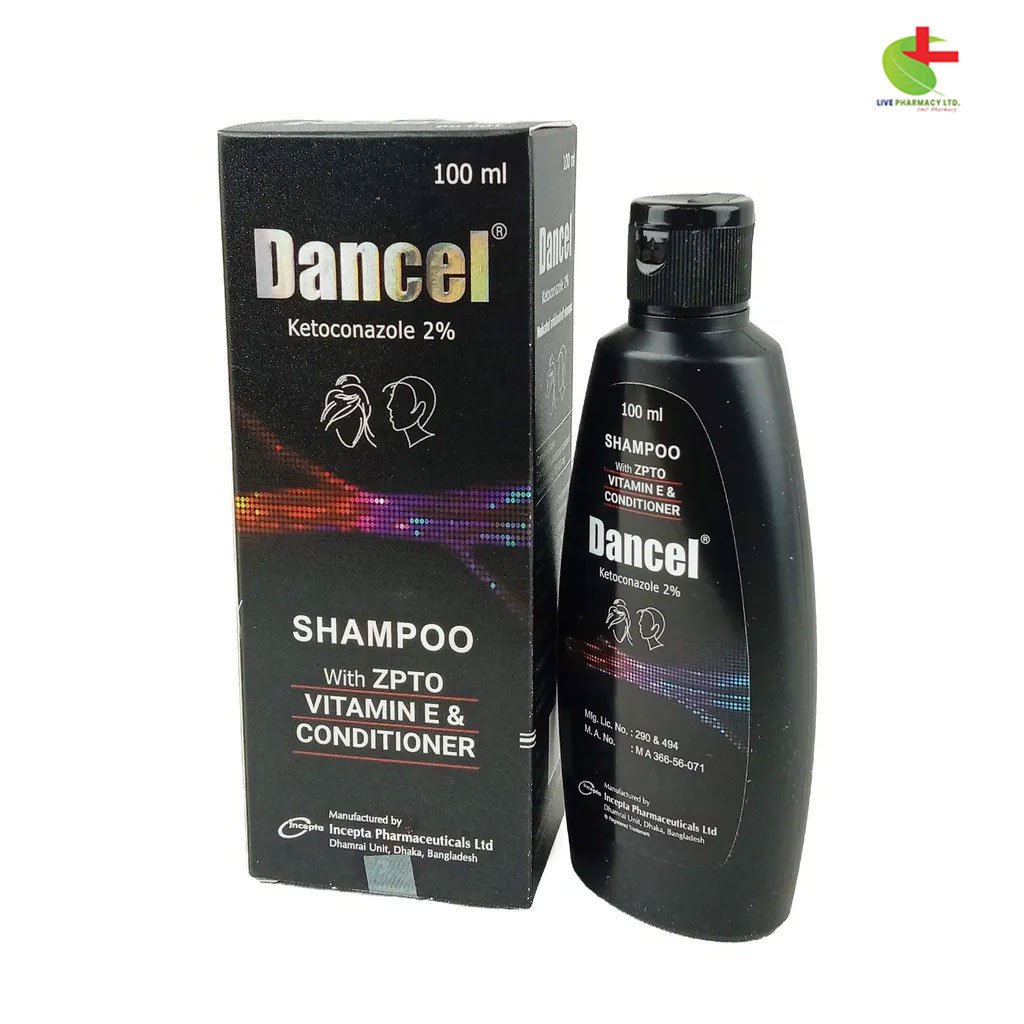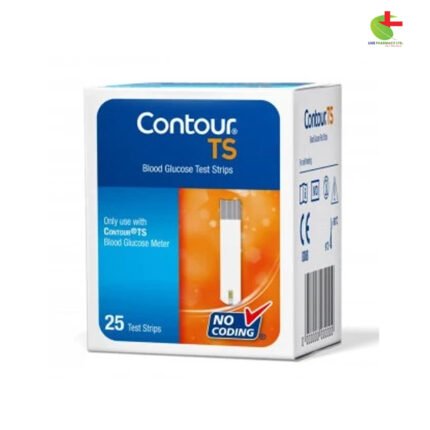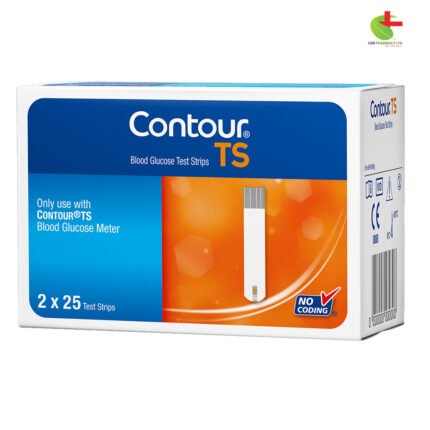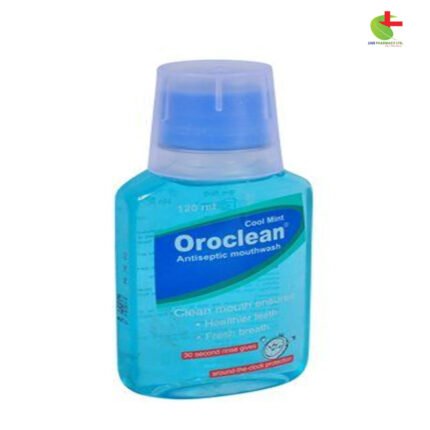Dancel Shampoo
230.00৳ Bottle (100ml)
- Dancel is a versatile antifungal treatment available in shampoo, cream, tablet, and bar forms, targeting a range of fungal infections including dandruff, athlete’s foot, and candidiasis.
- The shampoo is effective against Malassezia-related conditions, while the cream treats dermatophyte infections.
- The oral tablets address superficial and deep mycoses, including skin, hair, nails, and systemic infections.
- Safe for topical use during pregnancy, Dancel requires caution in patients with liver conditions when taken orally.
 Brand
Brand
|
Incepta Pharmaceuticals Ltd |
|---|---|
 Generics
Generics
|
Ketoconazole |
 Type
Type
|
Shampoo |
Indications
Shampoo: Dancel Shampoo is specifically formulated to treat and prevent infections associated with the yeast Malassezia (formerly known as Pityrosporum). This includes conditions like localized pityriasis versicolor, seborrheic dermatitis, and pityriasis capitis (dandruff).
Cream: Dancel Cream is intended for topical use in addressing dermatophyte skin infections. This includes tinea corporis, tinea cruris (commonly known as dhobie itch), tinea manus, and tinea pedis (athlete’s foot), caused by Trichophyton spp., Microsporum spp., and Epidermophyton spp. Additionally, Dancel 2% Cream is effective against cutaneous candidiasis (including vulvitis), candidal intertrigo (sweat rash), tinea versicolor, and seborrheic dermatitis linked to Malassezia spp.
Tablets: Indicated for the treatment of both superficial and deep mycoses:
- Dermatophyte and yeast infections affecting the skin, hair, and nails (such as dermatophycosis, onychomycosis, perionyxis, pityriasis versicolor, and chronic mucocutaneous candidiasis), particularly when topical treatments are inadequate due to extensive skin involvement or deeper lesions.
- Yeast infections of the oral cavity (oral thrush, angular cheilitis) and gastrointestinal tract.
- Vaginal candidiasis, especially in chronic or recurrent cases that do not respond well to topical therapies.
- Systemic mycotic infections, including systemic candidiasis, paracoccidioidomycosis, histoplasmosis, and coccidioidomycosis.
Dancel Tablets are also used for maintenance therapy to prevent recurrence of systemic mycotic infections and chronic mucocutaneous candidiasis, as well as for prophylactic treatment in patients with compromised immune systems, such as those with cancer, organ transplants, or burns.
Dancel Bar: This soap is suitable for treating all types of body fungal infections.
Consult a registered healthcare provider before using this medication.
Pharmacology
Ketoconazole acts by inhibiting the enzyme 14-α-sterol demethylase, a crucial cytochrome P-450 enzyme involved in converting lanosterol to ergosterol. This inhibition reduces ergosterol synthesis, increasing fungal cell permeability due to diminished ergosterol in the cell membrane. The resulting metabolic blockade leads to the accumulation of 14α-methyl-3,6-diol, a toxic metabolite. This alteration in membrane fluidity is thought to impair enzyme systems bound to the membrane due to the loosening of structural components.
Dosage & Administration
Shampoo: Apply ketoconazole 2% shampoo to the affected scalp or skin, leaving it for 3 to 5 minutes before rinsing.
- Treatment:
- Pityriasis versicolor: Use once daily for 5 days.
- Seborrheic dermatitis and pityriasis capitis: Use twice weekly for 2 to 4 weeks.
- Prophylaxis:
- Pityriasis versicolor: Use once daily for 3 days prior to summer.
- Seborrheic dermatitis and pityriasis capitis: Use once every 1 to 2 weeks.
Cream:
- For tinea pedis: Apply cream to affected areas twice daily, typically for 1 week for mild infections, extending treatment until several days after symptoms resolve for more severe cases.
- For other infections: Apply once or twice daily, continuing until signs and symptoms have disappeared. Typical treatment durations are: tinea versicolor (2-3 weeks), tinea corporis (3-4 weeks). If no improvement is seen after 4 weeks, reconsider the diagnosis. Good hygiene practices are crucial to prevent reinfection, especially since seborrheic dermatitis is chronic and prone to recurrence.
Tablet:
- For vaginal candidiasis: Administer 1 tablet (200 mg) twice daily for 5 days.
- For all other conditions: Take 1 tablet (200 mg) once daily until at least one week after symptoms have resolved and cultures are negative.
Duration of Treatment:
- Pityriasis versicolor: 1 to 6 weeks
- Dermatomycoses: 2 to 8 weeks
- Onychomycoses: 1 to 12 months
- Mycoses of hair and scalp: 1 to 2 months
- Chronic mucocutaneous candidiasis: 1 to 12 months
- Oral mycoses: 5 to 10 days
- Systemic candidiasis: 1 to 2 months
- Paracoccidioidomycosis, histoplasmosis, and other systemic mycoses: 1 month to 2 years
Ketoconazole Bar: For body fungus, apply gently to the entire body to create lather, allowing it to sit for 4-5 minutes before rinsing thoroughly.
Consult a registered healthcare provider before using this medication.
Interactions
Shampoo and Cream: No significant interactions reported.
Tablets: Absorption may be decreased by antimuscarinics, antacids, H2-blockers, PPIs, and sucralfate. Plasma concentrations may be lowered by rifampicin, isoniazid, efavirenz, nevirapine, and phenytoin. Additionally, Dancel may reduce the effectiveness of oral contraceptives and increase serum levels of CYP3A4 substrates, such as digoxin, oral anticoagulants, sildenafil, and tacrolimus.
Contraindications
Dancel is contraindicated in individuals with a known hypersensitivity to ketoconazole.
Side Effects
Shampoo: Generally well tolerated; however, mild irritation such as burning, itching, or contact dermatitis may occur. Rarely, users report oily or dry hair.
Cream: Common side effects include a burning sensation at the application site, erythema, and itching. Less common effects may include application site bleeding, discomfort, dryness, inflammation, irritation, paresthesia, and skin reactions such as bullous eruptions, contact dermatitis, rashes, skin peeling, and stickiness.
Tablets: Generally well tolerated, though nausea and itching can occur in some patients. Rarely, an idiosyncratic liver reaction has been reported (incidence 1:10,000).
Pregnancy & Lactation
Shampoo: As ketoconazole is minimally absorbed through the skin, its use is not contraindicated during pregnancy or lactation.
Cream: There are no well-controlled studies in pregnant or nursing women. Limited data suggest no adverse effects on pregnancy or fetal health from topical ketoconazole. Animal studies indicate reproductive toxicity with oral ketoconazole. No effects on breastfeeding infants are expected.
Tablets: Classified as pregnancy category C. Due to insufficient controlled studies in pregnant women, Dancel Tablets should be avoided during pregnancy and breastfeeding.
Precautions & Warnings
Shampoo: Gradual withdrawal of topical corticosteroids is recommended over 2 to 3 weeks while using Dancel Shampoo to prevent rebound effects. Increased hair shedding may occur with seborrheic dermatitis and dandruff, which has been rarely linked to Dancel Shampoo. Avoid eye contact; if the shampoo enters the eyes, rinse thoroughly with water.
Cream: Not for ophthalmic use. If a potent topical corticosteroid has been used previously for seborrheic dermatitis, allow a recovery period of 2 weeks before using Dancel 2% Cream to reduce the risk of sensitization.
Tablets: Monitor liver enzyme levels in patients with a history of liver disease during treatment. Discontinue Dancel therapy immediately if symptoms of liver reaction develop, such as nausea or fatigue, accompanied by pale stools, dark urine, or jaundice.
Overdose Effects
Shampoo: Overdose is unlikely, as Dancel Shampoo is for external use. In cases of accidental ingestion, only supportive measures are recommended. Inducing vomiting or gastric lavage should be avoided to prevent aspiration.
Cream: Excessive application may cause erythema, edema, and burning sensations, which typically resolve after stopping treatment. No specific measures are necessary for accidental ingestion.
Therapeutic Class
Antifungal medications for subcutaneous and systemic mycoses.
Storage Conditions
Store below 25°C, away from light and moisture. Keep out of reach of children.












Reviews
There are no reviews yet.